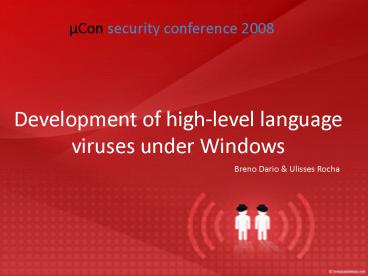Development of highlevel language viruses under Windows - PowerPoint PPT Presentation
1 / 25
Title:
Development of highlevel language viruses under Windows
Description:
1' will be replaced by the EXE's filename (with full path) ... Naming to svchost ( Dirty Way ) All we need to do is name our evil executable file to svchost.exe ... – PowerPoint PPT presentation
Number of Views:64
Avg rating:3.0/5.0
Title: Development of highlevel language viruses under Windows
1
Development of high-level language viruses under
Windows
µCon security conference 2008
- Breno Dario Ulisses Rocha
2
File Infection
- File infection overview
- Overwriting
- Prepending
- PE Infection
- Source File Infection
3
File Infection
- Prepend-like
- Most used technique for
- file infection in HLL-viruses
- Just reading/writing operations
- Deal with abstract .exe files instead of PE
structure - Can be implemented in almost all languages
4
File Infection
- Prepend-like (dirty side)
- Infected files get bigger, so the user may notice
- Tiny executables should be avoided for stealth
reasons
5
File Infection
- Alternate Data Streams (ADS)
- Requires to be running at least one hard drive
with the NT file system - (NTFS), and luckily most systems do these
days. - Compatibility with the Macintosh Hierarchical
File System (HFS). - Files stored on a HFS consist of two parts
(known as forks). - Data fork and Resource fork.
- Windows systems using NTFS stores Macintosh
resource forks in a hidden - NTFS stream.
- Information stored on resource fork does not
alter in any way the original file - (eg. Last modified date or file size).
6
File Infection
- Prepend ADS for stealth
- Hide virus body in the resource fork
- Infect file with a tiny executable instead of
the entire virus - Traveling problems
7
- Spreading
8
Spreading
- Search Mechanism
- In-Memory Strategies
- Direct Action
- Memory-Resident
- Temporary Memory-Resident
- How to Spreading (Most common mechanisms)
- Shared Folders
- P2P Folders
- USB Watcher
9
Spreading
- Registry Shell Spawning
- Temporary Memory-Resident
- Relies on the operating system
- How do you know which are EXE targets ?
- Windows registry
- HKEY_CLASSES_ROOT\exefile\shell\open\comm
and - "1"
- What does that ?
- "1" will be replaced by the EXE's filename
(with full path) - will be replaced by it's parameters.
10
Spreading
- Example
- File Name test.exe
- Path C\windows\
- Command Line
- "C\windows\test.exe" -arg1 -arg2
- Use that feature
- Change the registry entry to
- "C\Windows\System32\virus.exe" "1"
- Command Line
- "C\windows\system32\virus.exe"
"C\windows\test.exe" -arg1 -arg2 - "our virus will be executed
EVERY TIME an EXE file is started."
11
Registry Shell Spawning
12
- Self Protection
13
Process Hiding
- API Hooking ( Fashion Way )
- Intercepts messages of hooked process
- TaskManager retrieves information about the list
of processes running calling the function
NtQuerySystemInformation on ntdll - The goal is to intercept calls of
NtQuerySystemInformation made by taskManager and
drop the information of our evil process before
it reach taskManagers process - Some times avoided because of its complexity
- For this technique we need to inject a dll into
target process memory space - So as a payload the virus must carry in a dll
14
Process Hiding
- Naming to svchost ( Dirty Way )
- All we need to do is name our evil executable
file to svchost.exe - There is always more than one svchost process
running so our virus will stay unnoticed by the
user - Some says its a lame technique but the true is
its very effective - Its widely used cause there is no implementation
needed
15
Fucking AVs
- AV Killer
- AV Killer does the dirty job of takig AVs out of
orbit - The first thing we need to implement an AV
Killer is a list of AVs process names - The virus loops thru the running processes list
looking for specific names and kill them - The technique can be dangerous if is misused
16
- Advanced Code Evolution Techniques
17
Evolution of Code
- Encrypted Viruses
- Oligomorphic Viruses
- Polymorphic Viruses
- Metamorphic Viruses
Evolution of Code
18
Evolution of Code
- Evolution baby evolution!!!
- Antivirus defense techniques
- Signatures Verification
- Heuristic Analysis
19
Evolution of Code
- Encrypted
- First method implemented
20
Evolution of Code
- Encrypted Perl Virus
21
Evolution of Code
- Oligomorphic
- Evolved form of Encrypted Viruses
- Semi-polymorphics
- Multiple decription patterns
- Has the hability of hide in a random way
22
Evolution of Code
- Oligomorphic Perl Virus
23
Evolution of Code
- Polymorphic
- Next step of oligomorphics techniques evolution
- Oligmorphics X Polymorphics
- Techniques
- Junk instructions
- Permutation
- Entry Point Obfuscation
24
Evolution of Code
- Metamorphic
- Natural Polymorphics evolution
- Polymorphics X Metamorphics
- Black Box
25
References
- 29a labs ( vx.netlux.org/29a )
- Ready Rangers Liberation Front (
vx.netlux.org/rrlf ) - DoomRiderz ( vx.netlux.org/doomriderz )
- EOF-PROJECT ( www.eof-project.net )
- VX Heavens ( vx.netlux.org )































